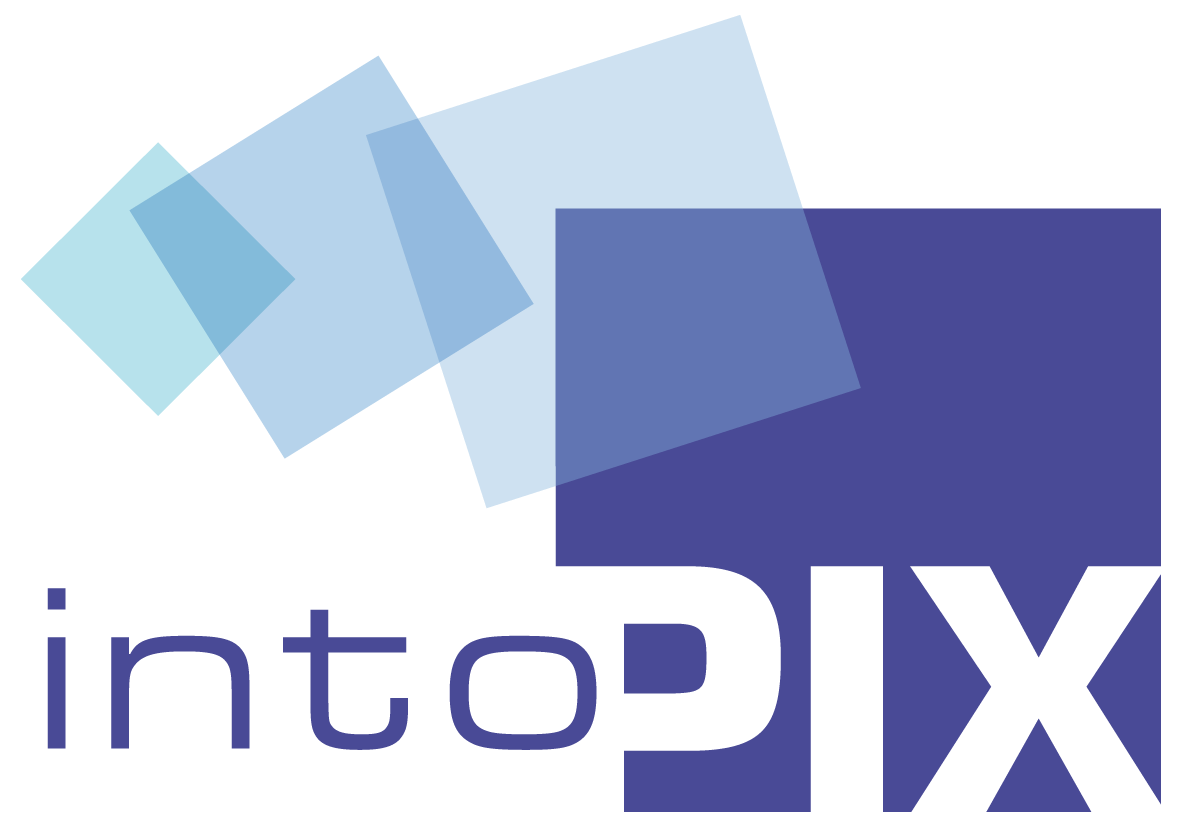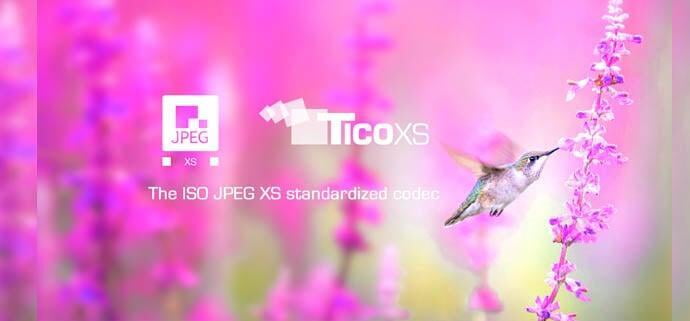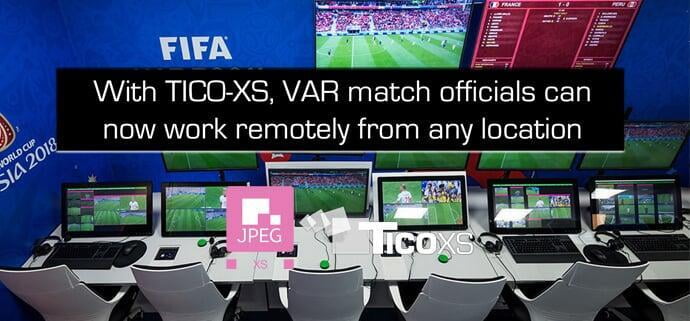
JPEG 2000 momentum in broadcast: why now?
Just a few years after its formal adoption by the digital cinema industry, JPEG 2000 is now being recommended in broadcast through various industry initiatives and standards. And: The JPEG committee is close to announcing the publication of its dedicated broadcast profile. Under the impulse of the Video Service Forum, JPEG 2000 transport over MPEG-2-TS is under standardization. Recently, several product manufacturers together formed the JPEG 2000 Alliance promoting the benefits of this format. Lastly, a wave of archiving initiatives are today favouring JPEG 2000 over other formats – including uncompressed TIFF – for saving their audio-visual heritage for future generations.
There is a good reason behind this momentum; the role of video compression formats has fundamentally changed over recent years. With ever growing transmission and storage capacity, coupled with increasing content quality and quantity, the problem is not the ability to robustly compress the content anymore. Today, the challenge is to manage the quality of the content and the access to it over entire workflows.
Formats offering compression ratios superior to JPEG 2000, such as MPEG-4 AVC/ H.264, still have to cope with the challenging consumer context where mobility, shared networks and wireless will remain key aspects. Today’s professional broadcasters prefer to avoid intrinsic image degradation in order to ensure and maintain a reliable image/ video quality from acquisition and production through to distribution and preservation: just what JPEG 2000 offers.
How does JPEG 2000 work?
Firstly, JPEG 2000 is an intra-frame compression format, i.e. each video frame is compressed independently as a still picture. This provides a quality guarantee, but does create a barrier to strong compression factors. Again, it all depends on the expectation of the format. For example, if the purpose of compression is the distribution of essence and no further editing is expected, long-GOP MPEG should typically be preferred. However, if the purpose is production, I-only compression formats are ideal.
After a pre-processing phase, mainly dealing with colour de-correlation, the video frames are passed through recursive low (L) and high (H) pass wavelet filters (see Figure 1). This process is known as the Discrete Wavelet Transform (DWT). It corresponds to an intra-component de-correlation that restructures the image by concentrating the image information in a small and very localized area. The recursive DWT also leads to a multi-resolution image representation. Next, the data is quantized and encoded in the Entropy Coding Unit. The quantization and the coding together achieve the compression before organizing the code stream according to a ratedistortion optimization.
It is worth underlining that the entire frame is compressed as a whole, without prior decomposition into blocks of pixels. Some consider that the artefacts at low bitrates are thereby visually much more acceptable than the well known blocking effects of the DCT based coding schemes, which may sound subjective.
Lastly, the output JPEG 2000 code stream presents an inherently scalable structure along several dimensions: colour components, resolutions (via the DWT), quality (via the rate-distortion optimization) and spatial regions thanks to an appropriate packetisation of the data.
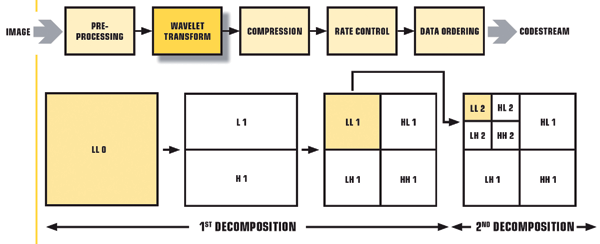
JPEG 2000 as an intermediate master format for the broadcast production workflow
An important demand of the industry today is high quality masters compatible with a wide range of delivery formats that can make the content available on any relevant existing platforms. This includes ingest, trans-coding, captioning, quality control and audio track management as linked processes. JPEG 2000 displays all the necessary features of such a high quality intermediate service master format:
• Quality: The high quality is preserved throughout the production process.
• Bit depth: JPEG 2000 is a 10 bits or higher format.
• No blocking artefacts.
• Scalability: this holds the promise of “create once for multiple purposes”.
• Easy editing: Even at the highest bit rates, its intrinsic flexibility makes it very usable on today’s laptop and workstation editing systems, with a limited number of full bit rate real-time video tracks. As computing hardware improves, the number of real-time layers can only increase.
• Intra-frame coding: Unlike motion compensation based compression methods referring to previous (P) or future (B) frames for inter-frame prediction, the intra-frame JPEG 2000 allows cutting the video signal at any place.
• Easy trans-coding: For high-end applications, trans-coding to an intermediate version may improve the workflow. JPEG 2000’s unobjectionable compression artefacts ensure that this is a clean as well as a quick operation when bit rate is at a premium. Correctly trans-coded 1920x1080 JPEG 2000 files @ 100 Mbit/sec have been found to be subjectively indistinguishable by most viewers from their 2048x1556 2K originals. Furthermore the wavelet based JPEG 2000 compression does not interfere with the final, usually DCT based, broadcast format.
JPEG 2000 as contribution format
Whether the contribution is over a satellite or fibre channel, given the move to HDTV and 3D-HDTV, compression is still required. Here again, the need for compression goes with a demand for high quality, which led most contribution system providers to integrate JPEG 2000. In 2009, the standardization of a flexible carriage of JPEG 2000 streams over MPEG-2-TS was initiated. It will define all necessary identifiers and field descriptors in future amendments of the MPEG-2-TS standard. This work follows the new standard JPEG 2000 broadcast profile to be published soon. Other key-features in favour of using JPEG 2000 for video transmission are:
• Very low latency: Reducing latency is crucial for live TV contribution. In the case of motion compensation, pictures are encoded using reference to past and future pictures with a consequent latency relative to the size of the full group of pictures (GOP). The intra-frame nature of JPEG 2000 compression reduces the latency. On average, JPEG 2000 produces latency of less than 1.5 frames for encoding or decoding. Some implementations even offer less than one frame for the full encoding-decoding cycle.
• Constant quality through encoding/decoding generations: JPEG 2000 maintains the quality after multiple compression steps (see Figure 2) and it is robust to pixel shifts. Figure 2: JPEG 2000 maintains the same level of quality after multiple generations of encoding and decoding.
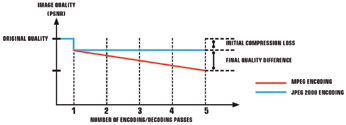
• Robust transmission, reduced video artefacts: Bit errors in a JPEG 2000 stream produce less visual artefacts than in GOP and DCT-based formats, as the errors appear as a short-lived blur in the impacted picture, without propagation to neighbour frames.
• Symmetrical Encoding/Decoding processing power: In systems with a small number of encoders and a large number of decoders, it is important to lighten the decoders as much as possible at the expense of the complexity and cost of the encoders. This is the philosophy behind MPEG-2 and MPEG-4. The architecture of contribution systems is very different, with the number of transmitters and receivers much more equally matched. The cost and complexity of the transmitter and the receiver should therefore ideally be about the same, with JPEG 2000 this is relatively easily achieved, as the encoding and decoding are symmetric processes.
JPEG 2000 as archiving format
For several years now, JPEG 2000 has been gaining ground as long term preservation format within the audio-visual community including digital cinema and broadcast.
Indeed, broadcasters and video archivists are looking for long-term digital preservation on disk. In most cases, the source material is not digital, but on film that needs to be scanned or high quality analogue videotape such as Betacam SP. As such, a destination digital format must then be selected. Key requirements here often include reducing the storage costs of uncompressed video while still maintaining indefinite protection from loss or damage. Moreover, the format should preferably enable digitized content to be exploited, which means providing flexibility – workflows again – and security.
For these reasons, several studies and user reports claim JPEG 2000 to be the solution for audio-visual archiving.
Note that not all the JPEG 2000 adopters rely on this format for the final archives exploitation. In particular, when the Internet is the prime target exploitation channel, the content is trans-coded from JPEG 2000 lossless to low bit rate H.264. The advantage is to also be more compatible with today’s web browsers – a weakness of JPEG 2000 – but it implies additional costs and complexity.
Three technical advantages of using JPEG 2000 for audio-visual archiving are usually stressed:
• Truly lossless compression: It enables a reduction in storage requirement of 50% on average while still allowing the exact original image information to be recovered.
• Scalability: allowing proxy extraction, efficient browsing, retrieval, trans-coding and streaming.
• Open standard: The JPEG 2000 standard supports every resolution, colour depth, number of components and frame rates. Moreover, a non-technical feature makes JPEG 2000 even more attractive for longterm projects: it is license and royalty free…
Conclusion
JPEG 2000 offers a number of advantageous features which makes it ideal for the broadcast production workflow as master format, contribution format or archiving format. Key strengths include high video quality, lossless compression, low latency, robustness to transmission errors, scalability and constant quality through encoding & decoding generations. Motion compensation based methods (e.g. MPEG family) are and will remain convenient solutions for the final diffusion of the content to the end-consumer. Complementarily, JPEG 2000 is fast becoming the mandatory standard for professional management of production workflow. As JPEG 2000 supports any resolution, colour depth, number of components and frame rates, it is also ready to address future applications.
